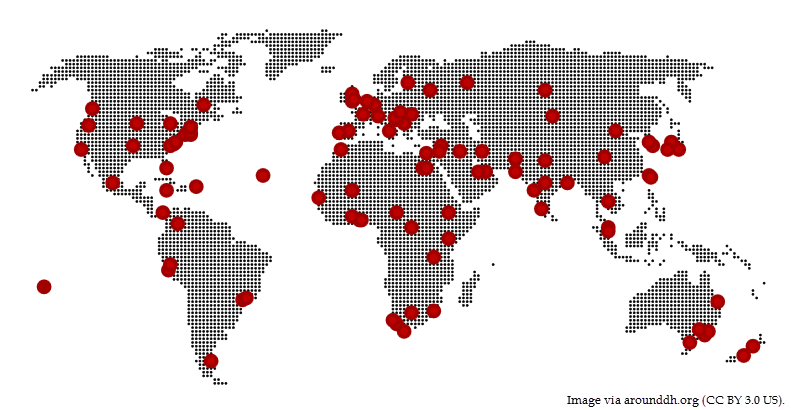This past Tuesday marked the final day of Around DH in 80 Days, a collaborative project that showcased a different digital humanities project from around the world every day for eighty days. Inspired by Jules Vernes’ classic novel, the project illustrates the diverse range of work that can be considered part of the “digital humanities.” Today, Glocal Notes is traveling Around DH and highlighting some of the projects from our service areas. Just in case you were wondering, there are plenty of copies of Vernes’ text in the library.

The complete Around DH map. / This image from arounddh.org is licensed under CC BY 3.0 US.
Around DH was started by Alex Gil, Digital Scholarship Coordinator at the Columbia University Libraries, and built with the help of many contributors. The first project was posted on June 22, 2014 and the last was published last week on September 9, 2014.
The project was motivated by the desire to highlight the disciplinary and regional diversity of digital humanities projects. Indeed, as you can see from the map above, multiple projects from every continent were included. If you are wondering what, exactly, digital humanities is all about, a look at some of the projects highlighted here should give you a better idea.
The concept behind Around DH is simple: every day for eighty days, a new digital humanities project appeared on the map. Crowdsourced suggestions for projects to include were submitted by contributors from around the world. The editorial team selected and wrote up the projects which were featured on the website. Each project is accompanied by a description of its scope and coverage. Most of these descriptions are rather brief, providing just enough information to give you a sense of the project before directing you to the project itself. Finally, the website was designed according to minimal computing principles, so as to be accessible in places with limited bandwidth.
Below are just a few examples of Around DH projects from our service areas here at the International & Area Studies Library. Visit arounddh.org to learn more about the project and see what other resources it has to offer. You can also follow along, or share additional projects, using the hashtag #arounddh on Twitter.
Africa
Day 10: Aluka
Aluka is a collaborative project to build a digital library of scholarly sources “from and about Africa” tailored to an undergraduate student audience.
East Asia
Day 1: Frog in a Well | 井底之蛙
This project, the first one to be featured, is a blog dedicated to publishing open-source scholarship about China, Japan, and Korea. Its name comes from an East Asian proverb that highlights the importance of openness and collaboration.
Eastern Europe
Day 76: Digitális Irodalmi Akadémia
This project is a “digital academy” of living Hungarian authors. Beyond providing digital access to the texts themselves, the project includes a rich collection of supplementary materials contributed by the authors.
European Union
Day 24: Quijote interactivo
Quijote interactivo is a beautiful digital edition of Cervantes’ Don Quijote. It is a high quality reproduction of the first edition of the work that allows the reader to turn the pages and search the full-text. Supplementary materials about the novel are included as well.
Latin America & the Caribbean
Day 16: Memorias de la Patagonia Austral
This project aims to provide access the a rich collection of primary source materials about the Patagonia region. It includes a wide variety of materials, ranging from newspaper articles to oral histories.
Middle East & North Africa
Day 52: AlexCinema
This project aims to preserve the history of Egyptian cinema, specifically in Alexandria. The film-making tradition in the city is over 100 years old and AlexCinema is an extensive bibliography documenting that tradition and its modern-day revival.
South Asia
Day 33: Indian Memory Project
The Indian Memory project is an online archive dedicated to the history of the Indian subcontinent. It includes a variety of resources, including images and oral histories.

